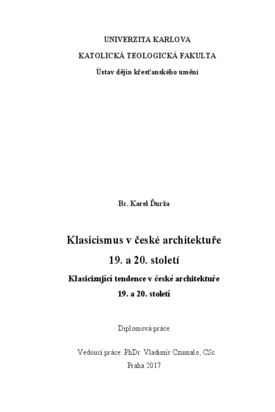Klasicismus v české architektuře 19. a 20. století
Classicism in Czech architecture of the 19th and 20th centuries
diplomová práce (OBHÁJENO)

Zobrazit/
Trvalý odkaz
http://hdl.handle.net/20.500.11956/93883Identifikátory
SIS: 166622
Kolekce
- Kvalifikační práce [2233]
Autor
Vedoucí práce
Oponent práce
Šmied, Miroslav
Fakulta / součást
Katolická teologická fakulta
Obor
Dějiny křesťanského umění
Katedra / ústav / klinika
Ústav dějin křesťanského umění
Datum obhajoby
7. 9. 2017
Nakladatel
Univerzita Karlova, Katolická teologická fakultaJazyk
Čeština
Známka
Dobře
Klíčová slova (česky)
Česká architektura, klasicismus, klasický, neoklasicismus, empír, palladianismus, romantismus, historismus, moderna, moderní klasicismus, meziválečná architektura, socialistický realismusKlíčová slova (anglicky)
Czech architecture, classicism, classical, neoclassicism, Empire style, Palladian architecture, romanticism, historicism, modernism, modern classicism, interwar architecture, socialist realismStudie zpracuje téma klasicismu v širším smyslu tohoto pojmu na materiálu české architektury. V úvodní kapitole pojmově vymezí klasické, klasicismus a neoklasicismus. Samostatně stručně pojedná o formování klasického kánonu v Evropě a nastíní vývoj klasicismů v dějinách české architektury v evropském kontextu. Systematicky pak v samostatných kapitolách zpracuje problematiku klasicismu 1. poloviny 19. století, období přísného a pozdního historismu a rané a vrcholné moderny. Zvláštní pozornost bude věnovat tématu klasického v českém myšlení o umění v meziválečném období a v letech okupace. Po analýze klasicizujících tendencí v architektuře socialistického realismu stanoví základní klasicizující snahy ve druhé polovině 20. století a na počátku století 21. Závěrečná kapitola na základě vybraných příkladů identifikuje rysy, které lze považovat za specifické pro klasicismus v české architektuře.
The thesis is aimed at the subject of classicism in a broader sense of this term and is based on the classicism period architecture in the Czech Republic. The introductory chapter intends to briefly and independently define and clarify the terms classical, classicism and neoclassicism, deal with the shaping of the classical canon in Europe and outline the evolution of classical features in the history of the Czech architecture in the European context. In separate chapters the thesis systematically follows the matters of classicism in the first half of the 19th century, in the periods of pure and late historicism and early and paramount modernism. Special attention has been paid to the matters of classicism in the Czech thoughts on art in the interwar period and during the German occupation. Having analysed the classicism-style tendencies in the socialist realism architecture the thesis identifies basic classicism-style aspirations in the 2nd half of the 20th century and in the beginning of the 21st century. The final chapter is dedicated to the identification of the main overall specifics of classicism in the Czech architecture based on a list of examples.
